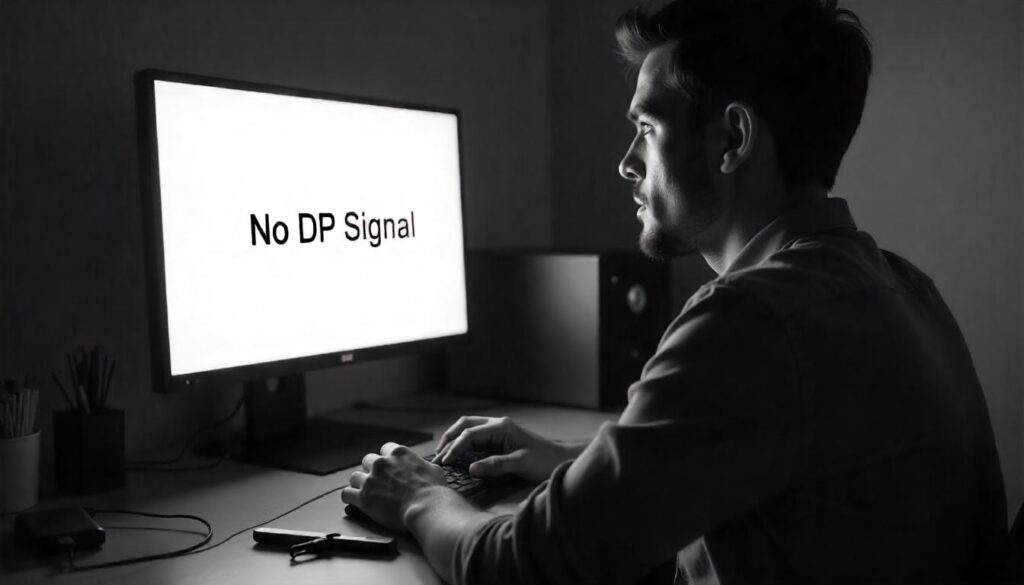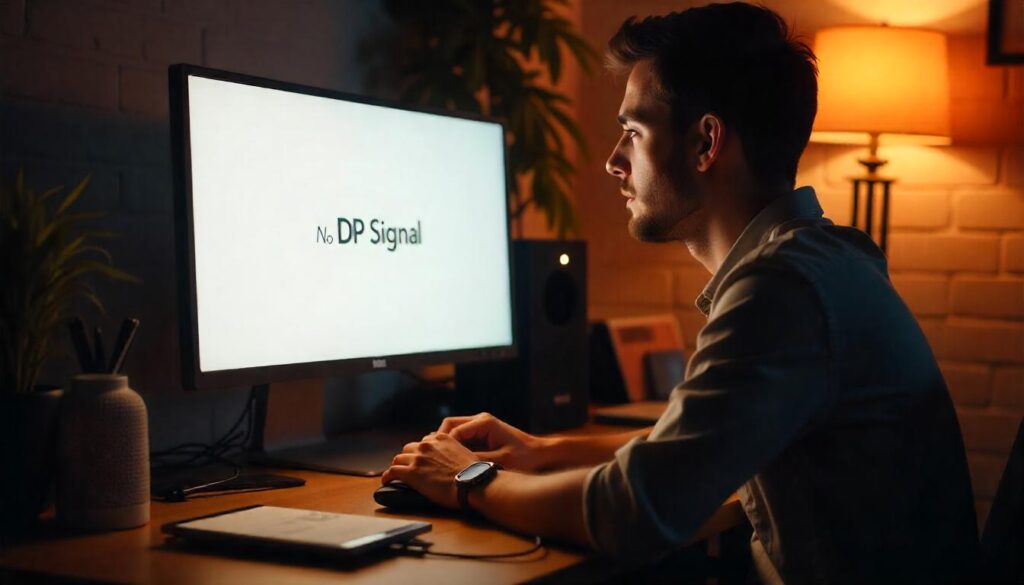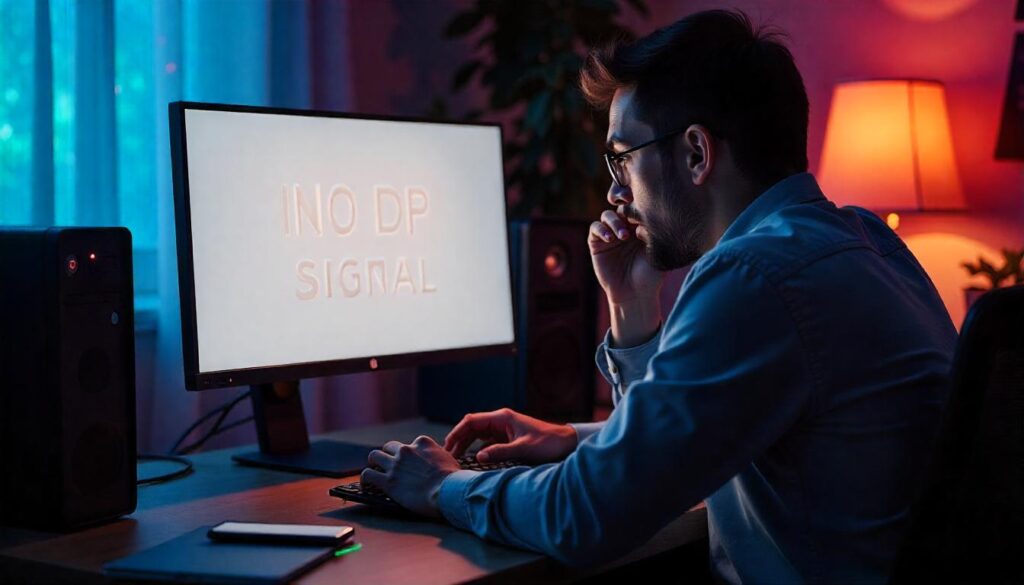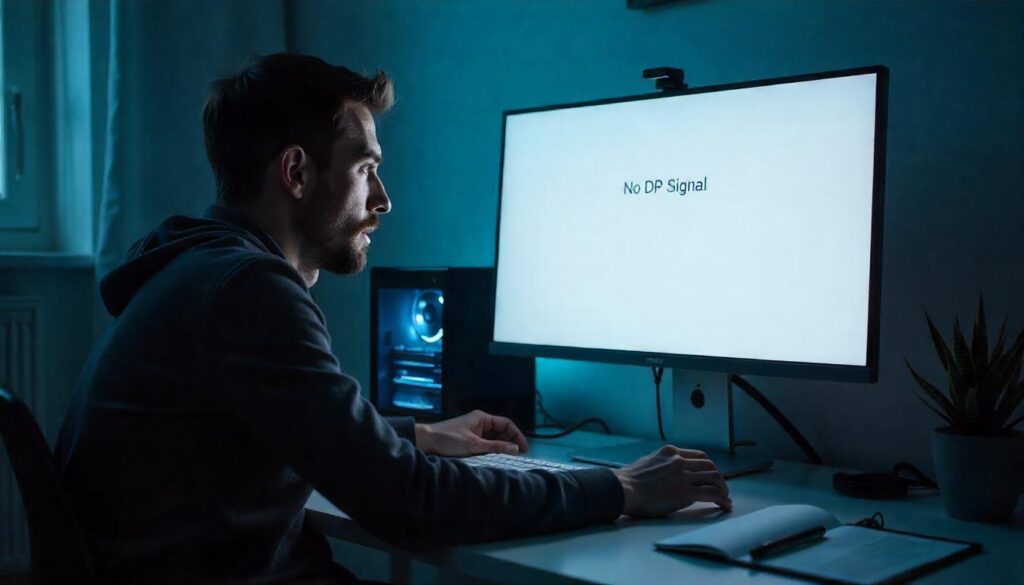You’ve just set up your monitor, plugged everything in, and fired up your PC—but instead of that glorious desktop display, you’re hit with a black screen and an ominous message: “No DP Signal From Your Device.” Great.
If you’re here, chances are your heart sank the moment that message popped up. Whether you’re a gamer ready to dive into a new release, a professional rushing to meet a deadline, or just someone trying to enjoy some screen time—you’re not alone. This DisplayPort (DP) signal issue is frustratingly common in 2025 and shows no signs of disappearing.
But take a breath. You can fix it—and probably faster than you think.
In this guide, we’ll walk you through what causes the “No DP Signal” error, how to fix it step by step, and how to prevent it from happening again. Let’s save your screen—and your sanity.
What Does “No DP Signal From Your Device” Even Mean?
Before we dive into the fixes, let’s decode what this message actually means.
DisplayPort (DP) is a digital display interface commonly used for connecting monitors to computers. When your monitor says “No DP Signal”, it’s not receiving any data from your device—usually a PC or laptop—even though it’s connected.
Think of it like calling someone whose phone is off. You’re dialing, but there’s just silence. In DisplayPort terms, the call isn’t going through, and your monitor is stuck waiting.
Keyword Biography Table: “no dp signal from your device”
| Attribute | Details |
|---|---|
| Keyword | no dp signal from your device |
| Search Intent | Informational, Troubleshooting |
| Primary Issue | Monitor shows “No DP Signal” when connected via DisplayPort |
| Common Devices Affected | Desktop PCs, Gaming Laptops, External Monitors |
| Likely Causes | Loose cables, wrong input source, outdated drivers, GPU problems |
| Top Variants | displayport no signal, fix no dp signal, monitor not detecting displayport |
| Frequent Users | Gamers, PC builders, office professionals, laptop users |
| First Known Use | Gained prominence with widespread DisplayPort adoption (~2010s onward) |
| Associated Tech | DisplayPort cable, graphics cards, monitor input settings |
| Related Forums | Reddit (r/techsupport, r/buildapc), Dell, HP, Microsoft Support |
| Trending Platforms | TikTok, YouTube (short fixes), How-To blogs |
| Ranking Content Types | Step-by-step guides, visual tutorials, community troubleshooting threads |
| Common Fixes | Reseat cable, change input source, update GPU drivers, restart devices |
| Advanced Fixes | BIOS/CMOS reset, try different DisplayPort version, test with new monitor |
| Ranking Sites | Systweak, MakeUseOf, TechRadar, Dell/HP Support |

Common Causes of the “No DP Signal From Your Device” Error
Here’s what could be going wrong behind the scenes:
1. Loose or Faulty Cable
This might sound basic, but it’s the most common issue. Cables wear out. Connections loosen. If your DisplayPort cable isn’t fully seated or is damaged, your monitor can’t get the signal.
2. Incorrect Input Source
Monitors with multiple ports (HDMI, DP, USB-C) need to know which one to listen to. If it’s set to HDMI and you’re using DisplayPort, nothing shows up.
3. Outdated or Corrupt Graphics Drivers
Out-of-date GPU drivers are notorious for causing display issues. Even a recent Windows update can sometimes knock drivers out of sync.
4. Monitor or GPU Hardware Glitch
It happens. Sometimes the issue isn’t the software or the cable—but the hardware. Either the DisplayPort on your GPU is bad, or your monitor has trouble interpreting the signal.
5. BIOS/CMOS or Configuration Issues
Especially with gaming PCs or custom builds, a BIOS reset or misconfigured settings can block DisplayPort output.
6. High Refresh Rate or Resolution Mismatch
Pushing your monitor too hard—say, trying to force 144Hz when your cable only supports 60Hz—can cause signal failure.
Quick Fixes: How to Fix “No DP Signal From Your Device”
Let’s start with the easiest and fastest steps. You might solve this in under 5 minutes.
1. Check the Cable and Reconnect Everything
- Unplug and reconnect both ends of your DisplayPort cable.
- Inspect the cable for bent pins or damage.
- Try another cable if you have one available.
- Use a different DisplayPort on your GPU if possible.
Pro Tip: Use a certified DisplayPort 1.4 or higher cable to avoid compatibility issues with modern high-res monitors.
2. Switch to the Correct Input on Your Monitor
- Grab your monitor remote or use its physical buttons.
- Manually select DisplayPort as the input source.
- Wait a few seconds—sometimes there’s a short delay in detecting the signal.
3. Restart Your Devices (Yes, It Actually Helps)
- Turn off your computer and monitor.
- Unplug both from power for 30 seconds.
- Reconnect and power them back on.
This clears temporary glitches and forces the GPU to resync with the monitor.
Advanced Troubleshooting Steps
Still no luck? Let’s dig deeper.

4. Update or Reinstall Your GPU Drivers
- Visit your graphics card manufacturer’s website (NVIDIA, AMD, Intel).
- Download the latest drivers.
- Use a clean installation to avoid leftover bugs.
If you’re unsure, tools like Driver Easy or Driver Booster (which often rank for these issues) can automate this—but always double-check the source.
5. Lower Refresh Rate and Resolution
- Boot into Safe Mode if your monitor isn’t displaying anything.
- Once inside Windows, go to Display Settings > Advanced Display Settings.
- Set refresh rate to 60Hz and a lower resolution to test.
Then, gradually scale up once the signal stabilizes.
6. Reset CMOS/BIOS (for Custom Builds)
For desktop users, especially those with gaming PCs:
- Power off and unplug your system.
- Remove the CMOS battery (the little silver coin) from your motherboard for 5-10 minutes.
- Reinsert and boot.
This resets BIOS settings, which might restore display output via DP.
Still Not Working? Try These Alternative Tests
- Try HDMI: If HDMI works, the problem is isolated to DisplayPort. That narrows things down.
- Test Another Monitor: Your GPU may be fine, and the issue could be the monitor.
- Use Another Device: Try plugging your device into a different monitor via DP to see if the signal goes through.
This trial-and-error method helps isolate the culprit: cable, GPU, monitor, or settings.
Prevention: How to Avoid DP Signal Issues in the Future
Now that your screen is (hopefully) alive again, here’s how to keep it that way:
- Always use high-quality DisplayPort cables.
- Avoid tugging, bending, or twisting cables behind your desk.
- Keep your drivers updated regularly.
- Don’t overload your monitor with unsupported refresh rates or resolutions.
- If using adapters (like USB-C to DP), make sure they are Active Adapters, not just passive ones.
Real People, Real Frustrations (And How They Solved It)
On forums like Reddit and Dell Support, users with setups like Alienware AW2725DF or Dell Latitude laptops often share variations of this nightmare. Some fixed it with a new cable, others updated drivers after a Windows update nuked their display settings.
A gamer on a PC-building subreddit recently shared how a tiny bit of dust in the GPU’s DP port was the cause. A quick blast of compressed air later? Boom—problem solved.
Prefer Watching? You’re Not Alone
Short TikTok videos demonstrating fixes like reseating the cable, restarting the monitor, or selecting the correct input source are going viral. People want fast, visual solutions—and platforms are listening. A 30-second clip might just save you an hour of hair-pulling.

The Bottom Line
The “No DP Signal From Your Device” error is frustrating—but fixable. Whether it’s a loose cable, outdated driver, or a confused monitor, you’ve now got the tools to tackle it head-on.
And the next time someone in your life stares blankly at a black screen wondering why their monitor isn’t working, you’ll be the tech hero who saves the day.
So, go ahead—check that cable, update that driver, and bring your display back to life. 💪

